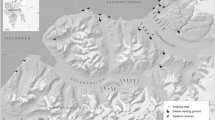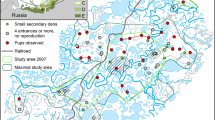Abstract
Even though intra-guild predators frequently prey on the same species, it is unclear whether diet overlap between two predators is a source of interspecific competition or whether predators simply use the same abundant prey resource. We measured the extent to which the diets of barn owls (Tyto alba) and long-eared owls (Asio otus) in Israel overlap and examined whether yearly differences in diet overlap correlate with barn owl breeding success. Pianka’s index of niche overlap was positively related to barn owl population size but not to its breeding success. The number of breeding barn owls was higher when long-eared owls consumed more rodents, suggesting that diet overlap most likely increased when rodents became more abundant. Therefore, in Israel, when these two owl species prey more often on rodents, their diets are more similar and interspecific competition is reduced. Unlike sympatric populations in Europe, in years when rodents are less abundant in Israel long-eared owls switch to hunting alternative prey (e.g., birds), perhaps to avoid competition with barn owls.


Similar content being viewed by others
References
Alatalo RV, Alatalo RH (1979) Resource partitioning among a flycatcher guild in Finland. Oikos 33:46–54
Andersson M, Erlinge S (1977) Influence of predation on rodent populations. Oikos 29:591–597
Aumann T, Aumann T (2001) An intraspecific and interspecific comparison of raptor diets in the south-west of the Northern Territory, Australia. Wildl Res 28:379–393
Bernard N, Michelat D, Raoul F, Quéré JP, Delattre P, Giraudoux P (2010) Dietary response of barn owls (Tyto alba) to large variations in populations of common voles (Microtus arvalis) and European water voles (Arvicola terrestris). Can J Zool 88:416–426
Birrer S (2009) Synthesis of 312 studies on the diet of the long-eared owl Asio otus. Ardea 97:615–624
Bolker BM, Brooks ME, Clark CJ, Geange SW, Poulsen JR, Stevens MHH, White JSS (2009) Generalized linear mixed models: a practical guide for ecology and evolution. Trends Ecol Evol 24:127–135
Bosakowski T, Smith DG (1992) Comparative diets of sympatric nesting raptors in the eastern deciduous forest biome. Can J Zool 70:984–992
Charter M, Izhaki I, Meyrom K, Motro Y, Leshem Y (2009) Diets of barn owls differ in the same agricultural region. Wilson J Ornithol 121:378–383
Charter M, Meyrom K, Leshem Y, Aviel S, Izhaki I, Motro Y (2010) Does nest box location and orientation affect occupation rate and breeding success of barn owls Tyto alba in a semi-arid environment? Acta Ornithol 45:115–119
Charter M, Izhaki I, Leshem Y, Roulin A (2012a) Diet and breeding success of long-eared owls in a semi-arid environment. J Arid Environ 85:142–144
Charter M, Peleg O, Leshem Y, Roulin A (2012b) Similar patterns of local barn owl adaptation in the Middle East and Europe with respect to melanic coloration. Biol J Linnean Soc 106:447–454
Charter M, Leshem Y, Meyrom K, Peleg O, Roulin A (2012c) The importance of micro-habitat in the breeding of barn owls Tyto alba. Bird Study 59:368–371
Charter M, Izhaki I, Leshem Y, Meyrom K, Roulin A (2015) Relationship between diet and reproductive success in the Israeli barn owl. J Arid Environ 122:59–63
Charter M, Izhaki I, Leshem Y, Meyrom K, Roulin A (2017) The relationship between weather and reproduction of the barn owl Tyto alba in a semi-arid agricultural landscape in Israel. Avian Biol Res 10:253–258
Cloyed CS (2014) Forest structure affects resource partitioning between pygmy and white-breasted nuthatches. Coevolution 2:26–30
Connell JH (1980) Diversity and the coevolution of competitors, or the ghost of competition past. Oikos 35:131–138
Garcia JT, Arroyo BE (2004) Food-niche differentiation in sympatric hen circus cyaneus and Montagu’s harriers Circus pygargus. Ibis 147:144–154
Hardin G (1960) The competitive exclusion principle. Science 131:1292–1297
Hutchinson GE (1957) Cold spring harbor symposium on quantitative biology. Concluding Remarks 22:415–427
Jaksić FM (1982) Inadequacy of activity time as a niche difference: the case of diurnal and nocturnal raptors. Oecologia 52:171–175
Kiat Y, Perlman G, Balaban A, Leshem Y, Izhaki I, Charter M (2008) Feeding specialization of urban long-eared owls, Asio otus, in Jerusalem, Israel. Zool Middle East 43:49–54
Kitowski I (2013) Winter diet of the barn owl Tyto alba and the long-eared owl Asio otus in Eastern Poland. North West J Zool 9:16–22
Klok C, De Roos AM (2007) Effects of vole fluctuations on the population dynamics of the barn owl Tyto alba. Acta Biotheor 55:227–241
Korpimäki E (1987) Dietary shifts, niche relationships and reproductive output of coexisting kestrels and dietary shifts, niche relationships and reproductive output of coexisting kestrels and long-eared owls. Oecologia 74:277–285
Korpimäki E, Norrdahl K (1991) Numerical and functional responses of kestrels, short-eared owls, and long-eared owls to vole densities. Ecology 72:814–826
Leader Z, Yom-Tov Y, Motro U (2008) Diet of the long-eared owl in the northern and central Negev Desert, Israel. Wilson J Ornithol 120:641–645
MacArthur RH (1958) Population ecology of some warblers of northeastern coniferous forests. Ecology 39:599–619
Meyrom K, Motro Y, Leshem Y, Aviel S, Izhaki I, Argyle F, Charter M (2009) Nest-box use by the barn owl Tyto alba in a biological pest control program in the Beit She’an Valley. Isr Ardea 97:463–467
Milchev B (2016) Dietary comparison of coexisting barn owl Tyto alba and eagle owl Bubo bubo during consecutive breeding seasons. Anim Biol 66:219–228
Muñoz-Pedreros A, Gil C, Yáñez J, Rau JR, Möller P (2016) Trophic ecology of two raptors, barn owl Tyto alba and white-tailed kite Elanus leucurus, and possible implications for biological control of Hantavirus reservoir in Chile. Wilson J Ornithol 128:391–403
Newton I (1998) Population limitation in birds. Academic Press, London
Nilsson IN (1984) Prey weight, food overlap, and reproductive output of potentially competing long-eared and tawny owls. Ornis Scand 15:176–182
Pavey CR, Gorman J, Heywood M (2008) Dietary overlap between the nocturnal letter-winged kite Elanus scriptus and barn owl Tyto alba during a rodent outbreak in arid Australia. J Arid Environ 72:2282–2286
Pavluvčík P, Poprach K, Machar I, Losík J, Gouveia A, Tkadlec E (2015) Barn owl productivity response to variability of vole populations. Plos One 10:e0145851
Pianka ER (1974) Niche overlap and diffuse competition. Proc Natl Acad Sci USA 71:2141–2145
Raczyński J, Ruprecht AL (1974) Effect of digestion on the osteological composition of owl pellets. Acta Ornithol 14:25–38
Schoener TW (1974) Resource partitioning in ecological communities. Science 185:27–39
Sergio F, Marchesi L, Pedrini P (2008) Density, diet and productivity of long-eared owls Asio otus in the Italian Alps: the importance of Microtus voles. Bird Study 55:321–328
Steen DA, Smith LL, Conner LM, Brock JC, Hoss SK (2007) Habitat use of sympatric rattlesnake species within the gulf coastal plain. J Wildl Manage 71:759–764
Steenhof K, Kochert MN (1985) Dietary shifts of sympatric buteos during a prey decline. Oecologia 66:6–16
Taylor I (1994) Barn owls: predator-prey relationships and conservation. Cambridge University Press, Cambridge
Tome D (2009) Changes in the diet of long-eared owl Asio otus: seasonal patterns of dependence on vole abundance. Ardeola 56:49–56
Tores M, Motro Y, Motri U, Yom-tov Y (2006) The barn owl—a selective opportunist predator. Isr J Zool 51:349–360
Torok J (1990) Resource partitioning among three woodpecker species Dendrocopos spp. during the breeding season. Ecography 13:257–264
Village A (1981) The diet and breeding of long-eared owls in relation to vole numbers. Bird Study 28:214–224
Wiens JD, Anthony RG, Forsman ED (2014) Competitive interactions and resource partitioning between northern spotted owls and barred owls in western Oregon. Wildl Monogr 185:1–50
Acknowledgements
We thank Maria Novoslov, Yuval Cohen, Tomer Chen, Inbal Segev, Hadas Sela for pellet cleaning, Kobi Meyrom for field assistance and Simon Birrer and Andrew Wolfenden for comments on the paper. We also thank the Israel Meteorological Center for weather data, and Yossi Leshem, the Israel Hoopoe Foundation, Society for the Protection of Nature Israel, Israel Ministry of Agriculture, Israeli Ministry of Environmental Protection, Addax and Oryx Foundation, the University of Haifa and the Minerva Center for Movement Ecology for funding.
Author information
Authors and Affiliations
Corresponding author
Rights and permissions
About this article
Cite this article
Charter, M., Izhaki, I. & Roulin, A. The relationship between intra–guild diet overlap and breeding in owls in Israel. Popul Ecol 60, 397–403 (2018). https://doi.org/10.1007/s10144-018-0633-6
Received:
Accepted:
Published:
Issue Date:
DOI: https://doi.org/10.1007/s10144-018-0633-6




